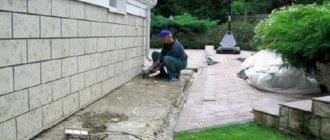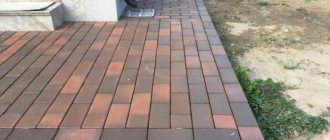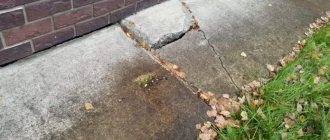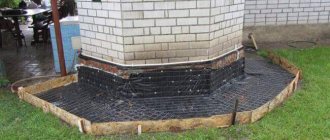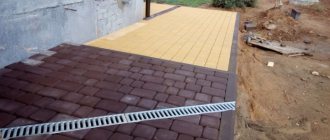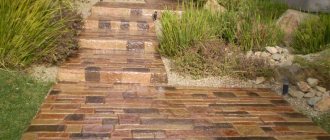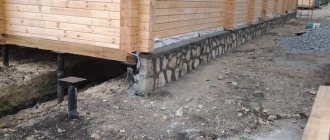During construction, three parameters are taken into account: a location with shallow aquifers, compliance with sanitary and hygienic standards and the aesthetic component of the well, how it will fit into the surrounding landscape.
The appearance of a well is difficult to imagine without a well-made blind area
Keeping the well clean
A danger to a well is any polluting runoff or object that accidentally gets into it. Therefore, care must be taken to eliminate the possibility of foreign objects getting into it. It is easy to protect yourself from precipitation, leaves and insects - you will need a tight-fitting flap cover. If you add a lock to it, the well will be conditionally protected from hooligan actions.
The main danger is melt and atmospheric water, which collects in the ground after rain or snowmelt and can penetrate into the well through aged or poorly sealed joints between the rings. The risk zone is the first few rings. The seams between them are carefully treated with waterproofing preparations, which quickly harden and do not pose a threat to human health.
Heavy artillery for draining wastewater and floods from a well is a simple blind area that was used by our ancestors. It has proven its effectiveness, so a well without a blind area is very rare.
What does the blind area around the well look like and what is it like?
A protective blind area is a special flooring around the well shaft, several meters wide and 1-3 rings thick.
Wells made not from standard reinforced concrete, but from modern polymer materials are much easier to maintain. Plastic pipes can withstand decades, having a large margin of safety and are practically invulnerable to corrosion processes. The shaft of such a well is a monolith, so the blind area is used only to stabilize the above-ground part of the shaft
The blind area consists of two layers: the lower underlying and the upper waterproof. Under the first layer you can put a cushion of sand or fine gravel.
The blind area around the well is classified according to the degree of rigidity of the materials used:
- Solid;
- Soft.
The following building materials are used:
- Clay;
- Concrete;
- Reinforced concrete;
- Combination of sand and polyethylene;
- Tile;
- A stone set on a cement mortar.
The most common options are clay and concrete.
Blind area around a well: how to protect the source from the negative influence of the external environment
Arrangement of the area around the well is the stage following the construction of the hydraulic structure. This task seems easy to accomplish - all work is carried out on the surface and does not involve complex technological processes.
However, violation of the rules is fraught with harmful consequences, up to the impossibility of further exploitation of the source, which could provide an entire household with clean natural water for many years.
Therefore, we will look in detail at how to make a blind area around a well.
Work to improve the area around the well should not be neglected. The structure must be protected from the negative effects of the environment. The water in the mine is not isolated from the outside world. There is a high risk of sediment or other water entering the trunk, which will lead to contamination of the source. As a result, you will have to carry out cleaning work, pump out water and wait for the height of the water surface to be restored.
Therefore, a waterproofed blind area around the well is needed - it will protect the mine from seepage of water from the surface. This is an important, but not the only function of the element of the above-ground equipment of the source:
- the blind area prevents premature destruction of the base of the wooden frame;
- the area around the well remains clean;
- after heavy rains, the approach to the source is not difficult due to excessive soil moisture;
- the design takes on a complete look and looks more aesthetically pleasing, even if decorative elements are not provided.
Another threat that the well blind area will protect against is the penetration of various fertilizers used in the garden into the soil in the immediate vicinity of the trunk. Chemical pollution poses a much greater threat than surface water. If it enters the aquifer, the ecology of the entire source will be disrupted. We will have to stop using wells located on the contaminated layer.
IMPORTANT TO KNOW: In some cases, there is no need for a blind area. For example, if the well is located on a hill, sediment and melt water drain naturally.
We invite you to familiarize yourself with Do-It-Yourself Pit - types of casing and drawings
The design of the blind area depends only on the imagination of the homeowners and their aesthetic preferences
The purpose of arranging the area around a log house or head is simple: it is necessary to protect the water column and aquifer from the effects of unwanted moisture or chemical compounds of inorganic origin.
It is important to pay due attention to the composition of the blind area and the correct sequence of laying layers. Otherwise, nature will “eat” the “pie” within a few years. The cushion will gradually collapse due to winter-spring heaving of the soil. Soil particles expand when frozen, which leads to detrimental consequences.
How to make a blind area around a well with your own hands? Preparation for constructing a protective zone around the log house requires compliance with certain rules. At first glance, these are simple requirements, but their implementation will avoid problems in the future. Among the norms are:
- The time interval between the completion of the well construction and the construction of the blind area. After any work related to violation of the integrity of the soil, soil subsidence occurs. You must wait until the process completes. The minimum pause between stages is one year. In some cases, work begins several years later.
During this time, the voids and gaps that arose during the construction of the mine and laying of the rings, which are also “in motion,” are naturally compacted. There is a horizontal displacement of the upper section, shrinkage of the structure.
- Preparing the area around the well. The radius is usually 1.5-2 m. In the intended area, remove 30-40 cm of soil, level and compact the bottom.
Additionally, the visible part of the upper ring or stone shaft of the well is cleared of soil. These works are carried out in order to obtain a high-quality waterproofing layer, which will act as a “safety cushion” and protect the mine from the penetration of water from the surface.
IMPORTANT TO KNOW: The construction of a blind area can be abandoned if automatic pumping equipment is installed and a drainage system is installed. However, residents of ecologically clean areas, remote from industrial enterprises and major highways, can afford such a luxury.
The concrete blind area does not imply bright design solutions - its purpose is utilitarian and practical
There are three ways to organize protective zones - clay, soft and concrete (or reinforced concrete) blind areas. In the first case, the top layer of the insulating “pie” is formed from clay or fertile soil layer. In the second, it is filled with concrete mortar.
Clay blind area ↑
It is considered the simplest version of this type of construction. This is done as follows:
- a pillow with a height of 10 to 50 cm is laid;
- the carefully compacted mass is covered with a top layer - this can be a flooring of stones or boards.
However, this method is not practical enough. Clay blind areas are gradually becoming a thing of the past. With heavy rainfall, the soft rock becomes wet, saturated with water, becoming slippery and unsafe.
In addition, the formation of voids and gaps between the clay layer and the rings of the well is often recorded.
Soft blind area ↑
It is a multi-layer structure, which consists of the following components, laid from bottom to top:
- waterproofing layer consisting of a special film. It is laid over the entire area of the protected zone with a transition to the vertical plane - the ring must also be protected;
- geotextile membrane as an additional safety layer;
- a sand cushion about 20 cm high. After laying, the layer is carefully compacted;
- a cushion made of crushed stone, the task of which is to strengthen the blind area and give it rigidity;
- backfilling - a layer of fertile soil is laid on top of the stone fraction;
- the top layer is formed from turf, gravel or other material depending on the landscape, design decision or practical feasibility.
Soft blind area is considered the best option
Concrete blind area ↑
The installation of this type of protection requires a lot of effort, material and time costs, and skills. In addition, it will be necessary to fulfill mandatory conditions under which the structure will last a long time and not collapse in the first years:
- to strengthen the concrete pad, it is recommended to lay reinforced mesh at the base of the structure;
- the mixture is prepared in several stages, gradually increasing the concentration of cement and at the final stage crushed stone is necessarily added to obtain a complete composition;
- An expansion joint is provided between the shaft ring and the mortar to prevent a tight connection between the two surfaces. This can lead to separation and displacement of the upper ring, which will compromise the environmental safety of the entire well.
We suggest you familiarize yourself with How to knit a washcloth with crochet loops and knitting needles for beginners step by step? Beautiful do-it-yourself washcloths for baths and showers for children and adults
Foamed polyethylene foam is used as a separating material, which is used to wrap the ring. If over time the concrete moves away from the tape, the separated joints are filled with waterproof sealant.
IMPORTANT TO KNOW: It is not recommended to use bituminous materials as a waterproofing layer when constructing a soft blind area due to their low environmental friendliness.
Excavation - the initial stage of constructing a blind area
The principle of constructing a protective layer, regardless of the chosen type - soft or concrete - is subject to a general algorithm:
- technological pause;
- site preparation and soil excavation;
- laying the cushion - either from a set of bulk and fractional materials, or from concrete;
- It is imperative that the blind area is planned on a slope - from the walls of the well to the adjacent area, so that the water flows down unhindered. The laying angle ranges from 2-5º when using concrete pavement to 5-10º when using soft materials.
However, the performance qualities of blind areas are different. Soft is considered more durable and problem-free according to the following indicators:
- is immune to winter and spring heaving of the soil, which eliminates the negative impact (squeezing) on the walls of the well;
- the separation of the upper ring from the lower ones with the subsequent formation of cracks into which surface water will flow is excluded;
- does not interfere with the natural movement of soils that can settle or shift;
- hidden holes and voids in the soil are not formed;
- if necessary, add sand, crushed stone or renew the layer of fertile soil;
- unlimited choice of covering - from decorative lawn to laying paving slabs.
An example of a blind area with a clay castle
A concrete blind area, especially reinforced with metal reinforcement, while externally reliable and impressive, is much more susceptible to destruction.
Also, its disadvantages include a high risk of negative impact on the walls of the well. In the event of landslides or significant soil movements, a concrete pad can destroy the integrity of the well frame, which will cause significant damage.
At the same time, this method of protection is practical and does not require constant maintenance.
How to make a clay blind area
Before starting the construction of any blind area, the well must be stable, and the soil around it must subside and stabilize. At least six months must pass from the time of construction.
A clay castle is a cheap option for a blind area, but bulky layers can act as a jack when the soil freezes and destroy the connection between the first two rings.
To lay clay, a trench 0.7-1 meters wide and 1.2-1.5 meters deep is dug around the well shaft. Soft, fatty clay is placed in this depression and compacted thoroughly. Poorly compacted clay leaves voids through which groundwater penetrates into the well shaft. Worse, if bacteria develop in them or rotting begins, after such a cavity breaks through, the well will have to be cleaned and completely disinfected. Vertical cracks in the blind area are formed due to subsidence of the soil around the well. Such a defect can be corrected by removing the old clay and laying a new lock.
To compact the surface of a clay castle, cobblestones are pressed into it, covered with crushed stone and other materials.
A regular clay castle in cross-section has a shape similar to a hemisphere; a slight slope towards the outer edge drains water from the surface. Water does not soak into the clay, so it flows into looser soil and does not get inside the well.
A clay castle is a very affordable and simple way to drain melt and rainwater from a well shaft. The main disadvantage is that the clay gets wet from atmospheric moisture and the well turns into an impregnable fortress with a swamp moat. To prevent inconvenience, the clay is covered with an additional waterproof layer, which means additional time and expense.
Concrete blind area
Construction of a clay castle
Scheme for creating a clay castle for a well.
The concrete strip around the well is durable, and with full compliance with the construction technology, a long service life is ensured.
To prevent surface water from entering the well, it is necessary to make a clay castle.
This is a very important point when building a well. It is best to do it in the spring, when the soil has already thawed. During the summer period, significant soil subsidence occurs under the influence of precipitation. If the subsidence is large, then clay must be added. The castle should be higher than the surface of the ground and sloped away from the well.
If the construction of a well is carried out in non-heaving soil (peat, sand or stone), then a clay castle need not be made.
When laying concrete rings of a well, at a distance of about 0.5 m from it, an empty space is left for constructing a clay castle. The depth of the clay seal is about 2.5 m. This space is filled with soft and greasy clay without foreign impurities. When laying clay, each layer is well compacted. Having completed the work of filling the free space with clay, you should not immediately begin building the blind area. Clay and soil will sag for a long time. Experts recommend keeping it for at least 1 year. During this period, you can make temporary flooring from boards.
How to make a concrete blind area
The concrete or reinforced concrete version of the blind area will create a durable, smooth coating that will last for many years if all standards are followed during construction. According to the technology, the creation of a concrete blind area consists of the following sequence:
- Excavation of the top layer of fertile soil (up to 0.5 m);
- Layer-by-layer filling of 15-20 sand with regular watering;
- A similar layer of gravel or small crushed stone is poured onto the sand at a slight slope towards the walls of the mine;
- Formwork is in progress;
- Reinforcement is laid in the recess.
- The well trunk is wrapped with roofing felt, construction film or other waterproofing material to prevent the creation of a monolith of the blind area and rings.
- The trench is filled with concrete solution.
The winding with rolled material acts as a damper. When the soil freezes and bulges, the blind area can tear off the top ring and break the tightness of the seams. To restore integrity it will be necessary to carry out complex repairs. On the contrary, if a section of the shaft is wrapped with roofing felt, then the blind area will move freely around it without causing destruction.
To strengthen the blind area, expansion joints are added to it - pieces of wooden boards that will take the blow and prevent the monolith from cracking.
What type of blind area should I choose?
Any foundation is built according to the following principles:
- a technological pause is maintained;
- excavation and preparatory work is being carried out;
- fractional material is laid;
- slope is planned;
- The final covering is being erected.
It cannot be said that one of the blind areas around the well will be better or worse. All design options have their own characteristics. Most often, experts recommend building a soft foundation. It does not compress the walls of the shaft, which eliminates displacement of the rings and clogging of the well. The soil can settle and shift. Over the years, you can complete the foundation without dismantling it. Absolutely any decorative covering can be laid on a soft base: from tree trunk cuts to paving slabs.
If you want to use the well without maintaining a technological pause, then the area around it can be equipped with dense soil. The mine is sprinkled with it at a slight slope. A wooden shield is knocked down from above, which will prevent this embankment from being washed away by precipitation. The well should be covered with a hatch, which can be made of boards, a sheet of metal or plastic.
A modern alternative - soft blind area
Rigid blind areas made of clay, concrete or piece materials have proven themselves well. They are easy to build, and if the technology is followed, they will serve their purpose well. But when equipping new wells, you need to pay attention to new technologies developed by specialists. We are talking about soft blind areas for drinking wells.
A special PVC film is used as a waterproofing material; its cost is quite high. As an alternative, you can buy dense polyethylene, or material from old advertising banners
The main component of soft blind areas is a waterproofing film; loose aggregates are used as a supplement: sand, screenings, gravel. Before explaining its structure, we present the main advantages:
- Does not require additional waterproofing;
- No cracks appear on the surface;
- Easily tolerates seasonal ground fluctuations;
- Will never cause rupture of seams between rings;
- Does not form voids where rotting debris accumulates;
- Suitable as a basis for decorative finishing;
- Easy installation, repair and removal;
- Easy to do with your own hands with minimal experience in construction.
Types of blind areas: features of arrangement
Low well
The blind area is made using different materials and technologies and can be hard or light. Solids perform:
- made of clay;
- made of concrete;
- tiles
When performing soft ones, use sand and hydrofilm.
An important point is when to install the blind area. Experts assure that after installation a certain period of time must pass, at least a year. During this time, natural shrinkage of the soil near the rings occurs and voids may form. It is also possible that the technology provides for displacement of the rings located on the surface, which will also negatively affect the protective coating if it is done immediately after construction. Therefore, immediately after construction, the blind area for the well should be temporary and made of sand or clay.
Clay protection looks like a layer of clay located near the circles in a special recess. This type is cheap, but has a big drawback: when it gets wet, it becomes slippery and sticky.
Clay blind area
By using concrete for this purpose, you will get a reliable coating. The process of arranging it is simple and can be done with your own hands. To do this, you must first make a recess and fill it with a layer of gravel. Then install the formwork. For greater strength, sometimes a mesh of reinforcement is laid on a layer of gravel, and then concrete is poured. An important condition for such a blind area is the need to isolate the walls of the circles from the concrete itself. Otherwise, this may lead to the displacement of the ring, the formation of a gap in this place, and the subsequent penetration of groundwater through it.
The concrete blind area of a well has a certain strength, but over time it ages and cracks form on it, through which impurities can penetrate into the well water. Therefore, it must be monitored and periodically carried out repairs. Reinforced concrete protection has great strength and durability.
Construction of a soft blind area
For a soft blind area, a trench is dug around the well shaft. It is advisable to completely extract the top fertile layer of mail and reach the beginning of the continental rock. A sufficient depth is considered to be 0.4-0.5 meters. The correct shape of the recess assumes a slight slope from the walls of the well. Then the bottom of the trench is compacted and lined with a thin layer of sand.
The walls of the well and the bottom of the pit are lined with waterproofing film. The upper edge of the material is fixed to the ring using construction tape. To avoid tension and breakthrough, the film is laid without tension, with small folds for reserve. Then the depression is filled with sand or other material. The filler must drain water well, then water will not linger on the surface, and it will always be dry near the well. You can fill different materials in separate layers.
After filling the drainage, the blind area is considered ready, but work can continue and decorate its surface with tiles and large pebbles. This will give the well a decorative look and completeness.
Advantages of a soft blind area
- Minimizing the risk of well rupture along the seam between the rings;
- Damage to the well and top covering is eliminated even during the processes of shrinkage and soil compaction;
- Repair and dismantling of the blind area is possible;
- The water drainage properties of waterproofing film are much better than concrete or clay;
- Service life reaches 80 years if installation technology is followed;
- The blind area around the well allows the use of any decorative covering from wood to decorative stones.
More on this topic on our website:
- Why do you need a blind area - types of blind areas? A blind area is a waterproof continuous stone covering, which is located along the perimeter on the outside of the building. Before you do it, you need to understand why the blind area is needed...
- How much does it cost to lay a blind area around a house made of tiles? A blind area is a structure that surrounds the house continuously around the perimeter and is closely adjacent to the base. The main function of the blind area is to protect the building from moisture entering…
- How to make a blind area from paving stones around a house Long and safe operation of various structures depends on a reliable foundation that resists negative factors, for example, erosion due to precipitation, floods and others. This problem is relevant in…
- Construction of a blind area around a concrete house - optimal parameters for a concrete blind area. A blind area is an architectural element of a building that performs many functions. It prevents moisture from penetrating into the foundation, basement and technical rooms of the house. Even a small amount of moisture...
